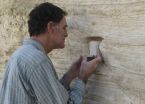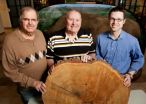(Press-News.org) Endoscopy has gone through amazing advancements in recent years. Microcameras on the tip of endoscopes supply images from the inside of the human body in ever higher resolution, which often makes it possible to identify tumors at an early stage. Endoscopes to date have some downsides, since they are expensive and, because of their multiple usages, have to be put through time-consuming and exhaustive cleaning procedures every time they are used. This problem might be solved by a new microcamera that the Fraunhofer Institute for Reliability and Microintegration (IZM) in Berlin, Germany has developed together with Awaiba GmbH and with the support of the Fraunhofer Institute for Applied Optics and Precision Engineering IOF in Jena, Germany. Martin Wilke, a scientist at the Fraunhofer Institute for Reliability and Microintegration, says "we can produce microcameras so inexpensively with our technology that doctors can dispose of endoscopes after using them only once." This is made possible by a new type of manufacturing process.
Digital camera systems consist of two components: a lens and a sensor that transforms the image into electrical signals. Electrical contacts on the sensor allow access to these signals and therefore also to the information of the image. Due to the way they are manufactured, these contacts are located between the sensor and the lens. The sensors are manufactured simultaneously in large numbers, like computer chips. Martin Wilke says, "you have to think of a book full of postage stamps where many thousand stamps are printed in one step. If you want to use them, you have to separate one from another. Instead of a sheet of paper, with image sensors you have a circular disc of silicon that is known as a wafer." About 28,000 image sensors fit onto one wafer and until recently, each and every one was sawed out, wired and mounted on the lens that was still missing. That means wiring them 28,000 times and mounting them just as often.
The researchers at the Fraunhofer Institute for Reliability and Microintegration have streamlined this process by developing a new way to access the electrical contacts. Now, the wiring process is faster and the entire camera system is smaller. The trick lies in the fact that they do not reach the contacts of each individual image sensor via the side any more but rather, simultaneously, with all sensors via their reverse side while they are still connected as a wafer. That means that you no longer have to mount the individual lenses. Instead, you can connect them with the image sensor wafers as lens wafers. Only then is the stack of wafers sawed apart into individual microcameras. Another upside is the fact that it supplies razor-sharp pictures even with very thin endoscopes. To date, the camera systems built into them had to be divided because of their size. The lens was at the tip of the endoscope and the sensor at the other end of the glass fiber strand. The new microcamera is small enough for the tip of the endoscope. It has a resolution of 62,500 pixels and transmits the image information through the endoscope via an electrical cable. Stephan Voltz, who is the CEO of Awaiba GmbH, says that "at 1.0 times 1.0 times 1.0 millimeters, this camera is as small as coarsely ground grain of salt – the smallest camera that we are aware of."
It is not only medical technology, but also the automotive industry that is interested in this tiny camera. Presently, they are researching the possibility of replacing outside rearview mirrors on cars with microcameras. This would reduce flow resistance and energy consumption. Beyond this, installed in fittings, this camera would be able to calculate the driver's eye movements and prevent him from nodding off for a few seconds. Stephan Voltz is happy about the wide range of possible applications: "Starting in 2012, using Fraunhofer's expertise, we will be able to bring disposable endoscopes to market for only a few euros – we already have the prototype."
INFORMATION:
Cameras out of the salt shaker
2011-03-15
ELSE PRESS RELEASES FROM THIS DATE:
A research study analyzes marine spill prevention policies in Spain
2011-03-15
The study analyzes the actions adopted by a dozen countries after suffering disasters similar to that of the Prestige, the oil tanker which sank off the coast of Galicia towards the end of 2002, provoking a spill of fuel-oil which turned out to be one of the biggest ecological disasters in the history of Spain. "We have seen that our country has not adopted technical nor legal preventative measures, as opposed to what happened in Germany with the shipwreck of the Pallas, for example, which produced a movement of a centralizing nature, in detriment to the federal spirit ...
Study helps explain how pathogenic E. coli bacterium causes illness
2011-03-15
Scientists at the National Institute of Allergy and Infectious Diseases (NIAID), part of the National Institutes of Health, have shown how the O157:H7 strain of Escherichia coli causes infection and thrives by manipulating the host immune response. The bacterium secretes a protein called NleH1 that directs the host immune enzyme IKK-beta to alter specific immune responses. This process not only helps the bacterium evade elimination by the immune system, it also works to prolong the survival of the infected host, enabling the bacterium to persist and ultimately spread to ...
A seismograph for ancient earthquakes
2011-03-15
Earthquakes are one of the world's biggest enigmas — impossible to predict and able to wreak untold damage within seconds. Now, a new tool from Tel Aviv University may be able to learn from earthquakes of the ancient past to better predict earthquakes of the future.
Prof. Shmuel Marco of Tel Aviv University's Department of Geophysics and Planetary Sciences in the Raymond and Beverly Sackler Faculty of Exact Sciences and his colleagues have invented a new tool which he describes as a "fossil seismograph," to help geophysicists and other researchers understand patterns ...
Osteoblasts are bone idle without Frizzled-9
2011-03-15
New research shows that the Wnt receptor Frizzled-9 (Fzd9) promotes bone formation, providing a potential new target for the treatment of osteoporosis. The study appears online on March 14 in The Journal of Cell Biology (www.jcb.org).
Adult bones are maintained by a balance of bone-forming osteoblasts and bone-resorbing osteoclasts. Although Wnt signaling affects this balance in mice and humans, the Wnt receptors involved remain unknown. A team of researchers led by Thorsten Schinke found that the Wnt receptor Fzd9 was upregulated during osteoblast differentiation and ...
Mini disks for data storage
2011-03-15
Tiny magnets organize themselves in vortices in the researchers' mini disks. The individual magnets can twist either in a clockwise or a counterclockwise direction in the disk. These two different states can be used in data processing just like switching the electricity "on" and "off" in conventional computers. In contrast to conventional memory storage systems, these magnetic vortices can be switched by the electrons' intrinsic spin and with far less power consumption.
In the exterior section of a vortex the magnetic particles align nearly parallel to one another while ...
Is your child's hobby making him sick?
2011-03-15
CHICAGO (March 14, 2011) – Research has shown that playing a musical instrument can help nourish, cultivate, and increase intelligence in children, but playing a used instrument also can pose a potentially dangerous health risk.
Used woodwind and brass instruments were found to be heavily contaminated with a variety of bacteria and fungi, many of which are associated with minor to serious infectious and allergic diseases, according to a study published in the March/April 2011 issue of General Dentistry, the peer-reviewed clinical journal of the Academy of General Dentistry ...
Use of $4 generic drug programs could save society billions of dollars, study shows
2011-03-15
PITTSBURGH, March 14 – If all eligible patients filled their prescriptions through a $4 generic drug program, the societal savings could amount to nearly $6 billion, according to a University of Pittsburgh Graduate School of Public Health (GSPH) study. Published in the March 14 issue of Archives of Internal Medicine, the study is the first to evaluate the potential national savings from a broad use of discounted generic medication programs that are available at many retail stores' pharmacies.
The study examined a large group of people who used generic medications or their ...
Improving financial reporting in private firms' interest, new study of emerging markets suggests
2011-03-15
Toronto – Improved financial reporting at private firms benefits not only potential outside investors but will help the firm make better business decisions for itself too, says a new study.
The study is authored by Ole-Kristian Hope, the Deloitte Professor of Accounting and an associate professor of accounting at the Rotman School of Management at the University of Toronto, uses World Bank data on small private firms in 21 emerging market countries – Thailand, Brazil and Pakistan having the largest samples. The data includes financing sources and information on tax environments. ...
Solar power systems could lighten the load for British soldiers
2011-03-15
A revolutionary type of personal power pack now in development could help our troops when they are engaged on the battlefield.
With the aim of being up to fifty per cent lighter than conventional chemical battery packs used by British infantry, the solar and thermoelectric-powered system could make an important contribution to future military operations.
The project is being developed by the University of Glasgow with Loughborough, Strathclyde, Leeds, Reading and Brunel Universities, with funding from the Engineering and Physical Sciences Research Council (EPSRC). ...
Old-growth tree stumps tell the story of fire in the upper Midwest
2011-03-15
CHAMPAIGN, Ill. — Researchers have constructed a 226-year history of fire in southern Illinois by looking at fire scars in tree stumps. Their study, the most in-depth fire history reported for the upper Midwest, reveals that changes in the frequency of fires dating back to the time of early European settlement permanently altered the ecology of the region.
The researchers took advantage of a 1996 timber harvest of old growth post oak trees in Hamilton County.
"I was just amazed at the fire scars in these trees," said William McClain, a botanist with the Illinois State ...




